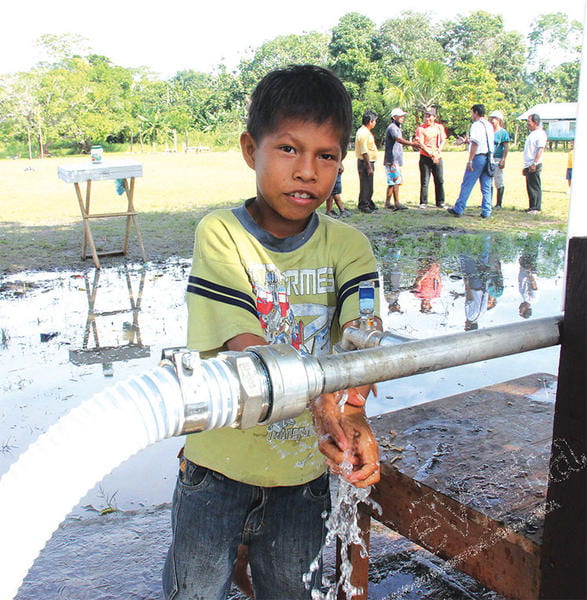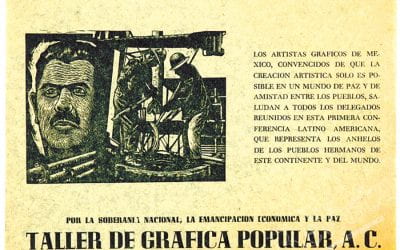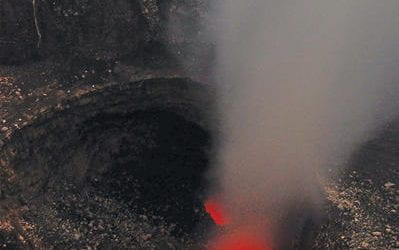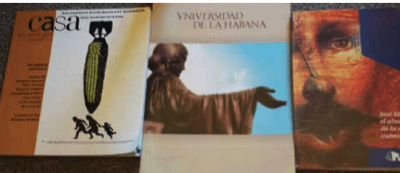Oil and Indigenous Communities
Sowing Discord in the Peruvian Amazon
On a drizzly morning in late February, a boat full of silent Kukama men motored slowly into the flooded forest off the Marañón River in northern Peru. Cutting the engine, one man began to row, maneuvering the boat past a partly submerged pile of rotting sacks of oily boots, gloves and rags. As he glided into a backwater, the oar stirred up an oily sheen accompanied by the smell of gasoline.
Two days earlier, a delegation of government officials had visited the site and declared it free of oil after a pipeline leak in June 2014 had spilled between 1,600 and 2,000 barrels of crude into the rain forest. Apparently they had not seen the waste dump and the oil slick, and had not noticed that the booms that had once formed a barrier across the pipeline canal were useless once the water rose and left them floating in the forest.
“They didn’t go to these places,” said one man, who had piloted one of the boats ferrying members of the delegation to the canal. “They didn’t look.”
The pipeline spill in Cuninico, a Kukama Indian village in the Peruvian Amazon, was small by most standards. It is dwarfed by the Deepwater Horizon spill in the Gulf of Mexico and the oil and wastewater dumped along the Corrientes, Pastaza and Tigre rivers to the north. For the villagers, however, it has been a lingering disaster. It also became a temporary employment opportunity, when the state-run oil company, PetroPerú, hired local workers to clean up the oil and contaminated soil and vegetation. But now, with the jobs and money gone, reality has settled in again, says Galo Flores, the apu or president of Cuninico.
“The spill violated our rights,” Flores says. “It has affected our entire life, but especially the water, because we don’t have safe water to drink.”
In Peru’s northeastern Amazon region, where there are virtually no roads, a river is the lifeblood of the communities along its banks. People drink its water and bathe and wash clothes and pots in it. The river is the only route for traveling to nearby fishing grounds, neighboring communities or distant cities. And it is the dwelling place of spirits, including those of relatives who drowned and whose bodies were never recovered. To pollute the river—created when sap flowed from the mythical lupuna tree to relieve a woman’s thirst—is also to contaminate their spirit world.
In Cuninico and other Kukama communities, fish are a source of both protein and income. Before the oil spill, the network of lakes and channels up the Cuninico River from the village was a rich fishing ground for people from about half a dozen communities. As word spread about the spill, however, the market dried up. Not only did buyers shun fish from Cuninico, but vendors who brought fish to sell in the community charged two or three times the usual market price.
With food and cash scarce, villagers jumped at the chance to work as day laborers for PetroPerú, first searching for the place where the pipe had ruptured, then laboring on cleanup crews. The wage of about $25 a day was three or four times the usual day labor rate. Women cooked or washed clothing for the hundreds of cleanup workers, and several families rented houses to the company for lodging company managers.
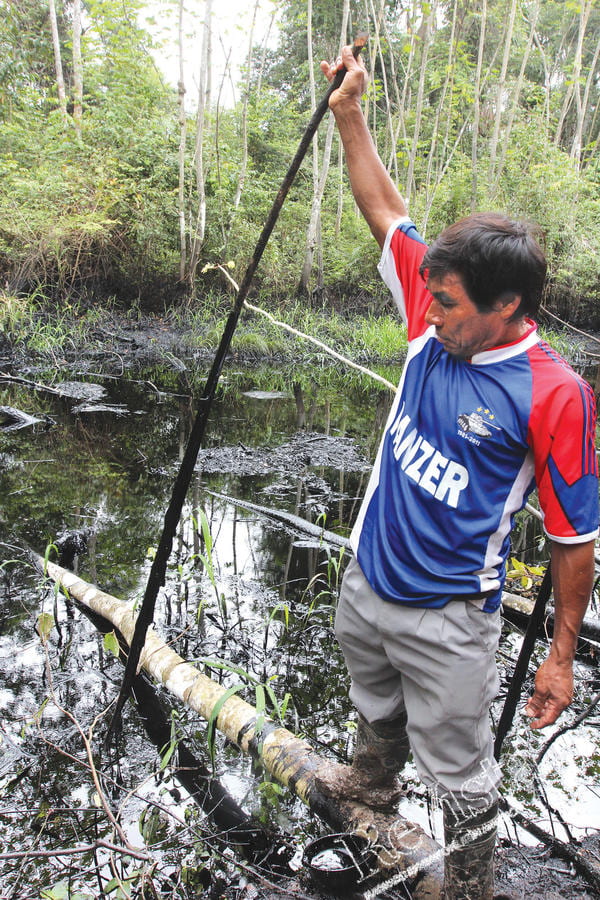
A man tests the depth of the oily water after a pipeline break near the Kukama community of Cuninico, in the lower Marañon River valley in northern Peru. Photo by Barbara Fraser.
ECONOMICS AND ENVIRONMENT AT ODDS
The effort started badly—more than a dozen men worked for a week searching for the rupture, submerged to their chests in oily water around the pipeline for hours at a time, clad only in regular clothes or stripped down to their underwear. Only after a national television news magazine showed footage of the scene did PetroPerú contract a company with experience in handling spills and provide the workers with protective gear. The state-run company also began to deliver bottled water, rice, canned fish, sugar and cooking oil to families in the village.
By October, nearly every adult male in the village and many from surrounding communities were working for PetroPerú or its contractors. Some women dropped out of the work force, feeling that they were neglecting household responsibilities. Cuninico was in the midst of a housing boom—virtually everyone was rebuilding, roofing or expanding their homes. The exception was the coordinator of Cuninico’s Catholic community, who declined to work for the company. His family’s home remained unchanged, with his son’s paintings of nature scenes still visible on some of the walls.
Water levels in the Marañón River and its tributaries rise and fall with the seasons, and company officials said they were working as quickly as possible to finish the cleanup before flooding began toward the end of the year. In mid-December, they declared the work finished and moved almost all their personnel out. The jobs and the money vanished, but demand for fish from Cuninico did not reappear. And when the high water brought ribbons of oil floating down the Cuninico River again, villagers worried anew about whether it was safe to eat the fish or drink or bathe in the water.
In an interview in March, company officials admitted that they had been unable to clean up part of the site—where sacks of oily vegetation and barrels filled with recovered oil had been stored, and where the boat oar had stirred up the oil slick—before it flooded, and said work would resume when the river levels went down again.
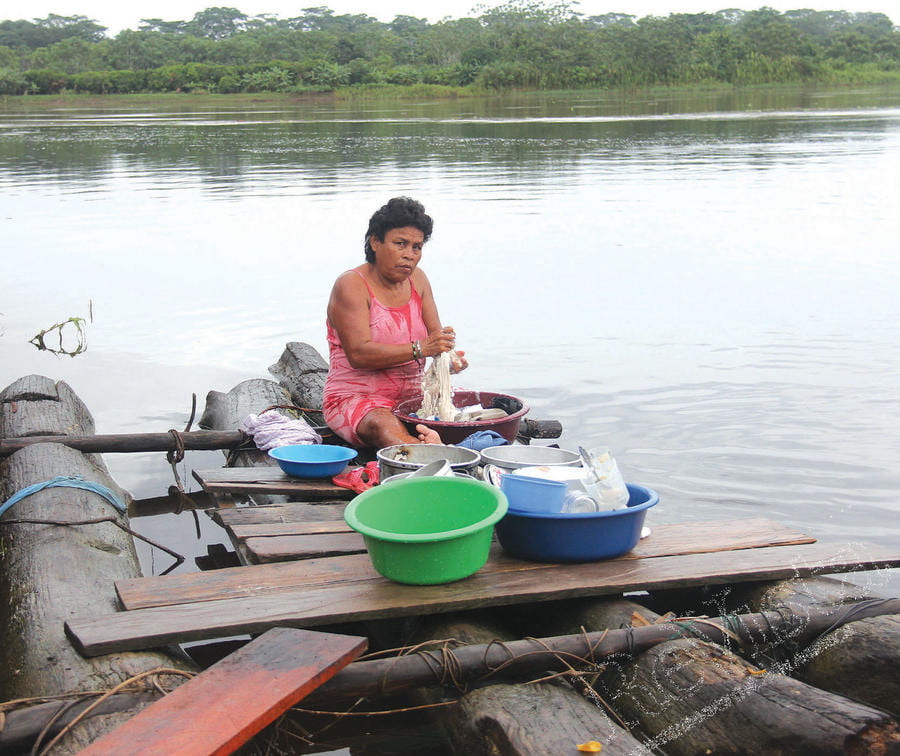
A woman washes clothes near the mouth of Cuninico River, traditionally her community’s source of water for drinking, cooking, and bathing. Photo by Barbara Fraser.
LONG HISTORY OF CONFLICT
The Cuninico villagers’ experience with the oil spill resembles similar events in other parts of the Amazon. The highest-profile case is that of Ecuador, with its prolonged and contentious legal battle over pollution from decades of poorly regulated oil operations in its northern Amazon region. A similar situation in Peru, although less widely publicized, has caused rifts within communities and indigenous organizations between those who want jobs and those worried about pollution, and over how to handle thorny issues such as remediation of and compensation for damages.
Occidental Petroleum and PetroPerú began operating in the northern Peruvian Amazon near the border with Ecuador in the 1970s, in two leases—known as Block 8 and Block 1AB—now operated by Argentina-based Pluspetrol. During most of that time, the hot, salty, metals-laden water pumped out of the wells along with the oil was dumped into the Corrientes, Pastaza, Tigre and Marañón rivers or streams that flow into those rivers. Lakes and soil were also polluted by oil spills, as was part of the Pacaya Samiria Reserve, a wetland supposedly protected under the Ramsar Treaty, where part of Block 8 is located.
Discontent over pollution in the region—known collectively as the cuatro cuencas or “four watersheds”—has been building steadily over the past two decades. Five Achuar communities on the Corrientes River inside Block 1AB reached a settlement with Occidental in September 2013, after nearly a decade of litigation in U.S. courts. The settlement, announced in Lima on March 5, 2015, a year and a half after it was reached, prohibits the parties from revealing details of the agreement, but Achuar leaders said it includes a development fund of an undisclosed amount, to be managed by the five communities and used for projects such as fish farms, health care and education.
In 2006, after health exams found cadmium and lead in the blood of indigenous villagers, demonstrators occupied various Pluspetrol facilities, including the airstrip across from the town of Trompeteros, on the Corrientes River. Those protests ended with a pact known as the Acta de Dorissa. Pluspetrol committed to remediation of contaminated areas and to pumping produced wastewater back underground, into either abandoned wells or new wells drilled for reinjection. It also agreed to provide funding for a government-run health program for the indigenous communities.
The reinjection program was completed, and the company claims on its website that it has remediated “almost all” of the affected sites. However, a 2014 report by the government’s environmental oversight office (Organismo de Evaluación y Fiscalización Ambiental, OEFA) identified more than 90 sites requiring cleanup. In January 2015, that office upheld fines of nearly US$10 million related to infractions in the Pacaya Samiria Reserve, which the company had appealed.

Dead fish and oily twigs gathered by villagers in Cuninico after an oil spill in June 2014. Photo by Barbara Fraser.
A YEAR OF NEGOTIATIONS
The lease on Block 1AB, now renumbered 192, expired in August 2015, but when the auction was held by the Peruvian government, there were no bidders. The government could simply extend Pluspetrol’s contract. Until recently, the indigenous federations in the cuatro cuencas had insisted that all damage be remediated and that a consultation should take place before a new round of bidding opened on the lease. Under Peru’s prior consultation law, which took effect in 2011, indigenous communities must be consulted about any development project or administrative decision affecting their communal rights.
They changed their position, however, after nearly a year of negotiations with government officials on issues ranging from territorial rights to health to compensation for damages. Under an agreement announced in March, the government decided to go ahead with preparations for the auction in parallel with a consultation, which is now under way in the watersheds.
The 19-point action plan signed by indigenous leaders and government representatives includes health studies, measures to improve health care in the communities, and installation of temporary water treatment plants. Government officials put the total cost at about US$30 million, not including a remediation fund and development projects for communities in the four watersheds. At a press conference in April, Environment Minister Manuel Pulgar-Vidal told foreign journalists that under its contract, PlusPetrol is responsible for remediating all damage in the two blocks, and that the government remediation fund would be used for “contingencies” or emergencies.
At the time the agreement was signed, conflicts were continuing in parts of Block 1AB/192, where some communities, afraid that Pluspetrol might pull out without compensating them for damages, were negotiating individual deals with the company. Some indigenous leaders said the tactics were fragmenting the organizations—a common complaint in Amazonian regions where extractive industries operate—and called for close monitoring of implementation of the March agreement.
Both territorial rights and prior consultation are potential flashpoints, not just there but in other parts of the Peruvian Amazon where oil and gas concessions overlap indigenous communities. More than 1,000 Amazonian indigenous communities in Peru still lack formal title, in an area totaling some 20 million hectares, according to the Interethnic Association for Development of the Peruvian Amazon (Asociación Interétnica de Desarrollo de la Selva Peruana,AIDESEP). Titling applications are stalled especially in places where infrastructure such as oil pipelines, drilling platforms or roads is located on community lands, according to Wendy Pineda, who heads AIDESEP’s geographic information systems team.
Designation of several new reserves to protect semi-nomadic groups that still shun contact with outsiders has also been on hold, and both indigenous leaders and environmental groups have protested the expansion of the Camisea gas field—in the tropical lowlands of the southern Cusco region—into the Nahua-Kugapakori-Nanti Reserve, which is inhabited by both nomadic and recently settled groups.
Most of the Peruvian Amazon is now parceled into oil and gas concessions, and the government had planned to auction at least a dozen of them this year, but with low international oil prices making exploration less attractive to companies, those plans are likely to be put on hold. In May, Hunt Oil informed the Native Federation of the Madre de Dios River and Tributaries (Federación Nativa del Río Madre de Dios y Afluentes, FENAMAD) that it was suspending exploration in part of a block that overlaps the Amarakaeri Communal Reserve, a protected area in southeastern Peru jointly managed by indigenous communities and the Peruvian park service. The company said it had not found the gas it had expected and that it would reevaluate its data before deciding on its next steps. In August, the government extended Hunt’s exploration permit by three years.
When the damage from the past 40 years will be cleaned up, however, remains an open question. Meanwhile in Cuninico, when children break out in rashes, mothers worry that it is because they are bathing in polluted water. And they worry about the future. A year after an oil slick and a mass of dead fish signaled a break in the pipeline, they still have no buyers for their fish.
Fall 2015, Volume XV, Number 1
Barbara Fraser is a freelance journalist based in Lima, Peru.
Related Articles
Mexico’s Energy Reform
The small, white-washed classroom at the University in Minatitlán, Veracruz, was packed with a couple dozen people who, although neighbors, had never met…
Geothermal Energy in Central America
When we think about global technology leaders, Central America does not typically come to mind. But Central American countries have indeed been in the…
Building Bridges with Cuban Libraries
Since the beginning of the U.S. trade embargo on Cuba in the 1960s, the Harvard Libraries have been unable to purchase materials directly from Cuban…

